technical specifications FIAT IDEA 2007 1.G Owners Manual
[x] Cancel search | Manufacturer: FIAT, Model Year: 2007, Model line: IDEA, Model: FIAT IDEA 2007 1.GPages: 314, PDF Size: 4.78 MB
Page 165 of 314
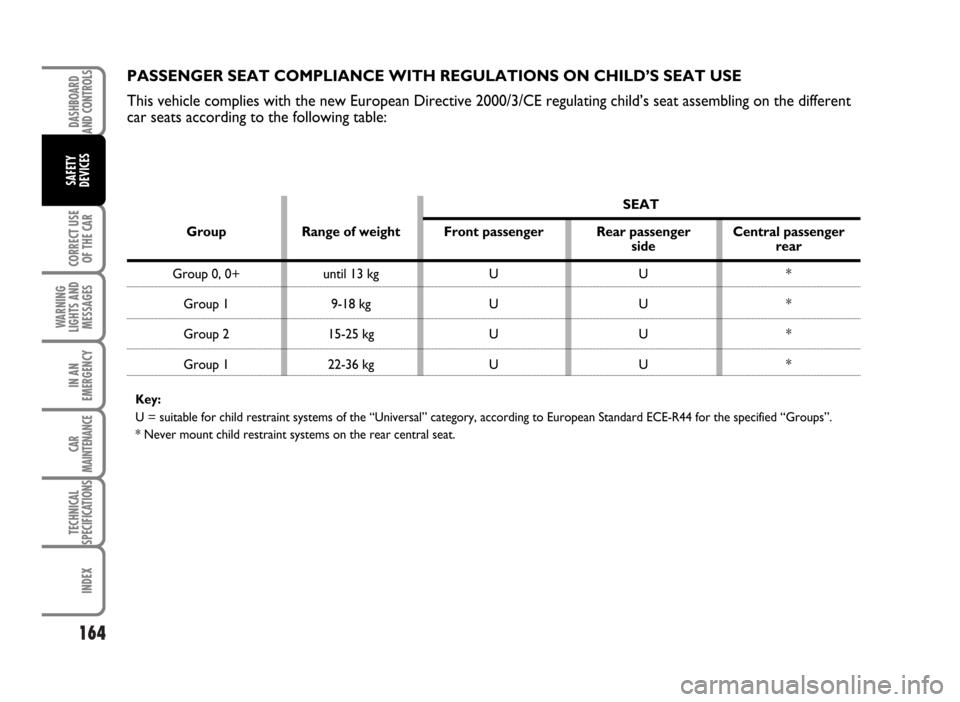
164
CORRECT USE
OF THE CAR
WARNING
LIGHTS AND
MESSAGES
IN AN
EMERGENCY
CAR
MAINTENANCE
TECHNICAL
SPECIFICATIONS
INDEX
DASHBOARD
AND CONTROLS
SAFETY
DEVICES
PASSENGER SEAT COMPLIANCE WITH REGULATIONS ON CHILD’S SEAT USE
This vehicle complies with the new European Directive 2000/3/CE regulating child’s seat assembling on the different
car seats according to the following table:
SEAT
Group Range of weight Front passenger Rear passenger Central passenger
side rear
Group 0, 0+ until 13 kg U U *
Group 1 9-18 kg U U *
Group 2 15-25 kg U U *
Group 1 22-36 kg U U *
Key:
U = suitable for child restraint systems of the “Universal” category, according to European Standard ECE-R44 for the specified “Groups”.
* Never mount child restraint systems on the rear central seat.
Page 166 of 314
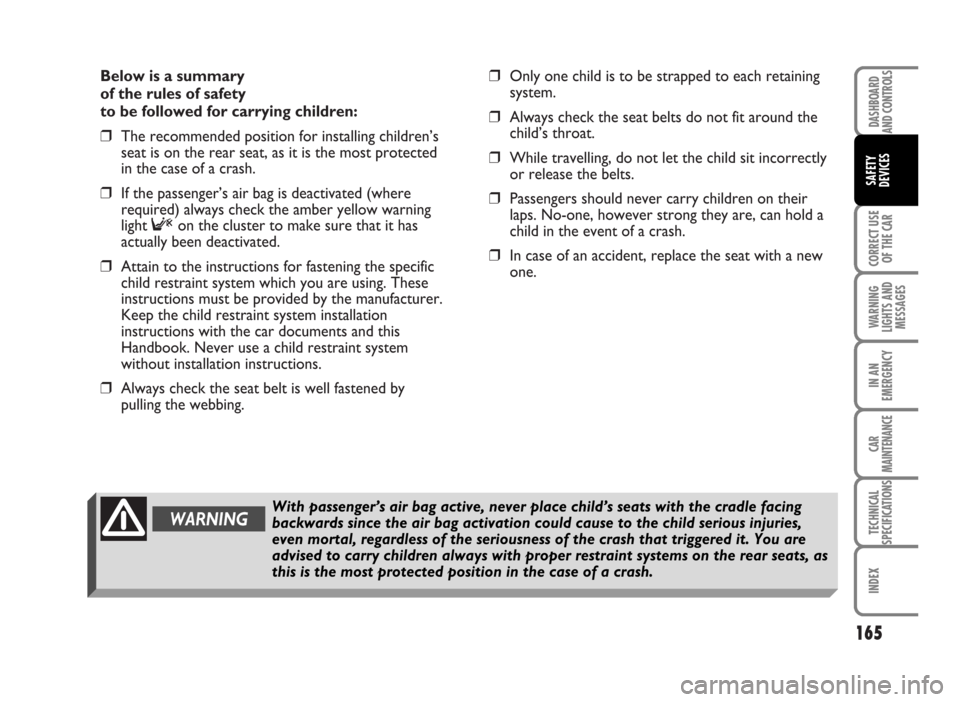
Below is a summary
of the rules of safety
to be followed for carrying children:
❒The recommended position for installing children’s
seat is on the rear seat, as it is the most protected
in the case of a crash.
❒If the passenger’s air bag is deactivated (where
required) always check the amber yellow warning
light Fon the cluster to make sure that it has
actually been deactivated.
❒Attain to the instructions for fastening the specific
child restraint system which you are using. These
instructions must be provided by the manufacturer.
Keep the child restraint system installation
instructions with the car documents and this
Handbook. Never use a child restraint system
without installation instructions.
❒Always check the seat belt is well fastened by
pulling the webbing.❒Only one child is to be strapped to each retaining
system.
❒Always check the seat belts do not fit around the
child’s throat.
❒While travelling, do not let the child sit incorrectly
or release the belts.
❒Passengers should never carry children on their
laps. No-one, however strong they are, can hold a
child in the event of a crash.
❒In case of an accident, replace the seat with a new
one.
165
CORRECT USE
OF THE CAR
WARNING
LIGHTS AND
MESSAGES
IN AN
EMERGENCY
CAR
MAINTENANCE
TECHNICAL
SPECIFICATIONS
INDEX
DASHBOARD
AND CONTROLS
SAFETY
DEVICES
WARNINGWith passenger’s air bag active, never place child’s seats with the cradle facing
backwards since the air bag activation could cause to the child serious injuries,
even mortal, regardless of the seriousness of the crash that triggered it. You are
advised to carry children always with proper restraint systems on the rear seats, as
this is the most protected position in the case of a crash.
Page 167 of 314
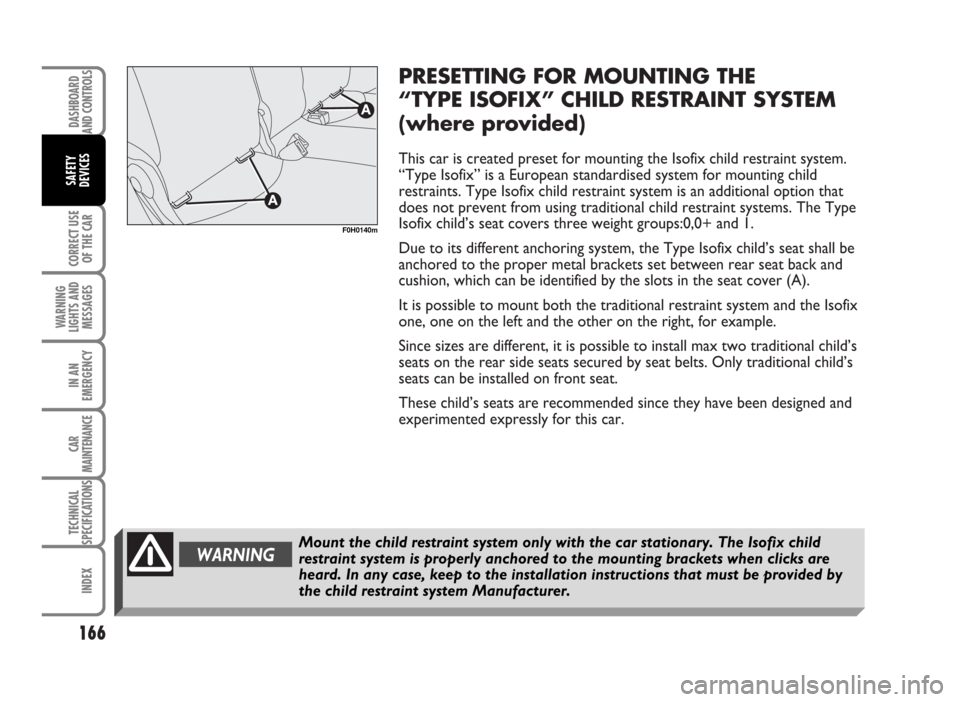
PRESETTING FOR MOUNTING THE
“TYPE ISOFIX” CHILD RESTRAINT SYSTEM
(where provided)
This car is created preset for mounting the Isofix child restraint system.
“Type Isofix” is a European standardised system for mounting child
restraints. Type Isofix child restraint system is an additional option that
does not prevent from using traditional child restraint systems. The Type
Isofix child’s seat covers three weight groups:0,0+ and 1.
Due to its different anchoring system, the Type Isofix child’s seat shall be
anchored to the proper metal brackets set between rear seat back and
cushion, which can be identified by the slots in the seat cover (A).
It is possible to mount both the traditional restraint system and the Isofix
one, one on the left and the other on the right, for example.
Since sizes are different, it is possible to install max two traditional child’s
seats on the rear side seats secured by seat belts. Only traditional child’s
seats can be installed on front seat.
These child’s seats are recommended since they have been designed and
experimented expressly for this car.
166
CORRECT USE
OF THE CAR
WARNING
LIGHTS AND
MESSAGES
IN AN
EMERGENCY
CAR
MAINTENANCE
TECHNICAL
SPECIFICATIONS
INDEX
DASHBOARD
AND CONTROLS
SAFETY
DEVICES
F0H0140m
WARNINGMount the child restraint system only with the car stationary. The Isofix child
restraint system is properly anchored to the mounting brackets when clicks are
heard. In any case, keep to the installation instructions that must be provided by
the child restraint system Manufacturer.
Page 168 of 314
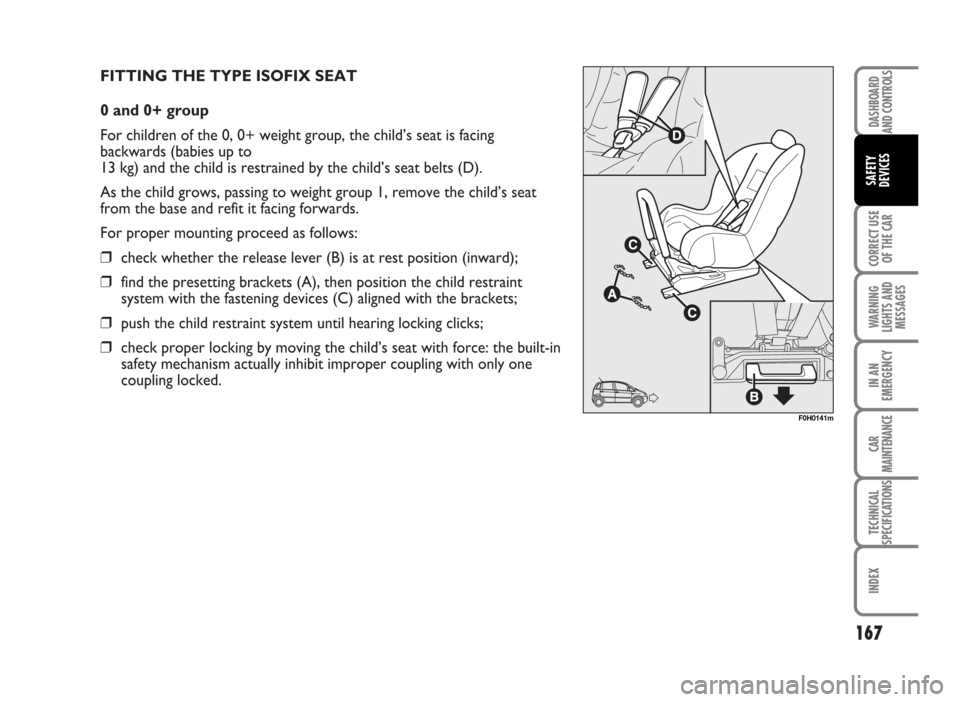
FITTING THE TYPE ISOFIX SEAT
0 and 0+ group
For children of the 0, 0+ weight group, the child’s seat is facing
backwards (babies up to
13 kg) and the child is restrained by the child’s seat belts (D).
As the child grows, passing to weight group 1, remove the child’s seat
from the base and refit it facing forwards.
For proper mounting proceed as follows:
❒check whether the release lever (B) is at rest position (inward);
❒find the presetting brackets (A), then position the child restraint
system with the fastening devices (C) aligned with the brackets;
❒push the child restraint system until hearing locking clicks;
❒check proper locking by moving the child’s seat with force: the built-in
safety mechanism actually inhibit improper coupling with only one
coupling locked.
167
CORRECT USE
OF THE CAR
WARNING
LIGHTS AND
MESSAGES
IN AN
EMERGENCY
CAR
MAINTENANCE
TECHNICAL
SPECIFICATIONS
INDEX
DASHBOARD
AND CONTROLS
SAFETY
DEVICES
F0H0141m
Page 169 of 314
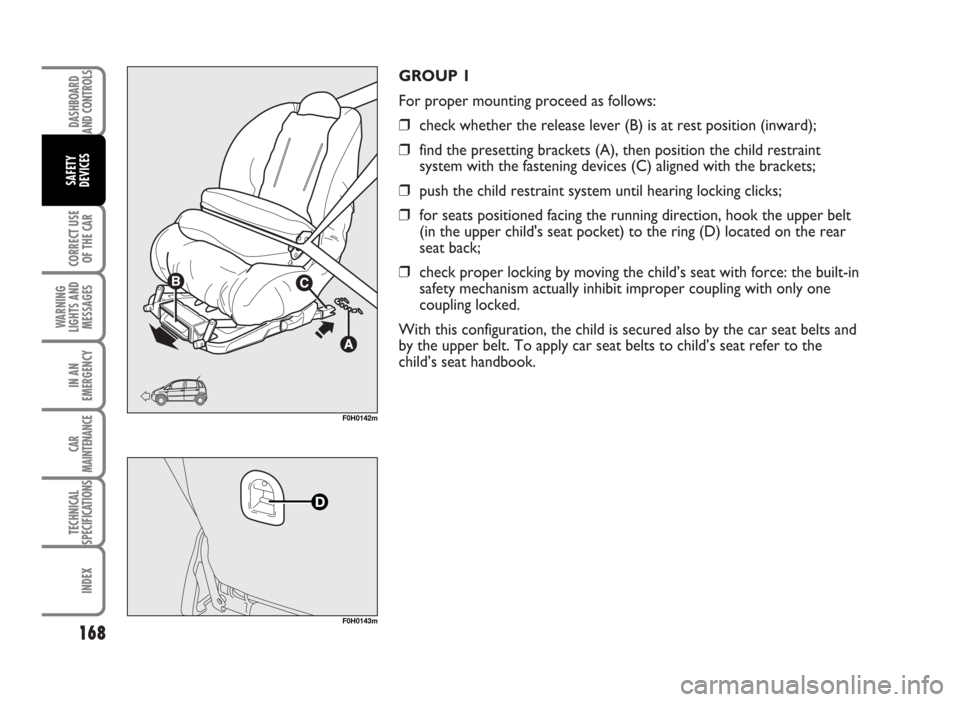
GROUP 1
For proper mounting proceed as follows:
❒check whether the release lever (B) is at rest position (inward);
❒find the presetting brackets (A), then position the child restraint
system with the fastening devices (C) aligned with the brackets;
❒push the child restraint system until hearing locking clicks;
❒for seats positioned facing the running direction, hook the upper belt
(in the upper child's seat pocket) to the ring (D) located on the rear
seat back;
❒check proper locking by moving the child’s seat with force: the built-in
safety mechanism actually inhibit improper coupling with only one
coupling locked.
With this configuration, the child is secured also by the car seat belts and
by the upper belt. To apply car seat belts to child’s seat refer to the
child’s seat handbook.
168
CORRECT USE
OF THE CAR
WARNING
LIGHTS AND
MESSAGES
IN AN
EMERGENCY
CAR
MAINTENANCE
TECHNICAL
SPECIFICATIONS
INDEX
DASHBOARD
AND CONTROLS
SAFETY
DEVICES
F0H0142m
F0H0143m
Page 170 of 314
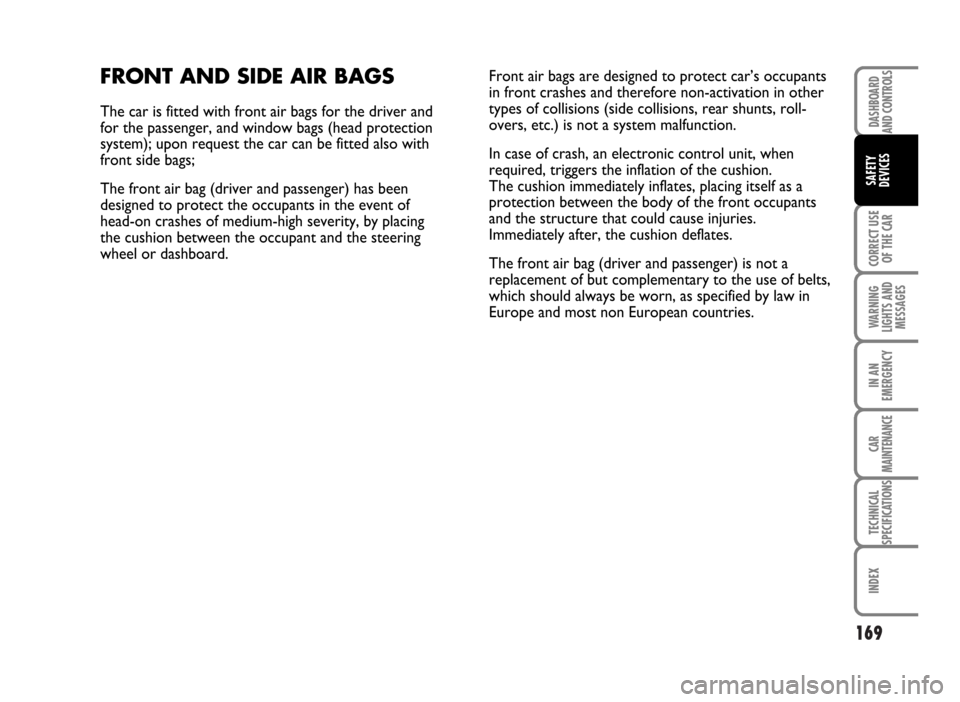
169
CORRECT USE
OF THE CAR
WARNING
LIGHTS AND
MESSAGES
IN AN
EMERGENCY
CAR
MAINTENANCE
TECHNICAL
SPECIFICATIONS
INDEX
DASHBOARD
AND CONTROLS
SAFETY
DEVICES
FRONT AND SIDE AIR BAGS
The car is fitted with front air bags for the driver and
for the passenger, and window bags (head protection
system); upon request the car can be fitted also with
front side bags;
The front air bag (driver and passenger) has been
designed to protect the occupants in the event of
head-on crashes of medium-high severity, by placing
the cushion between the occupant and the steering
wheel or dashboard.Front air bags are designed to protect car’s occupants
in front crashes and therefore non-activation in other
types of collisions (side collisions, rear shunts, roll-
overs, etc.) is not a system malfunction.
In case of crash, an electronic control unit, when
required, triggers the inflation of the cushion.
The cushion immediately inflates, placing itself as a
protection between the body of the front occupants
and the structure that could cause injuries.
Immediately after, the cushion deflates.
The front air bag (driver and passenger) is not a
replacement of but complementary to the use of belts,
which should always be worn, as specified by law in
Europe and most non European countries.
Page 171 of 314
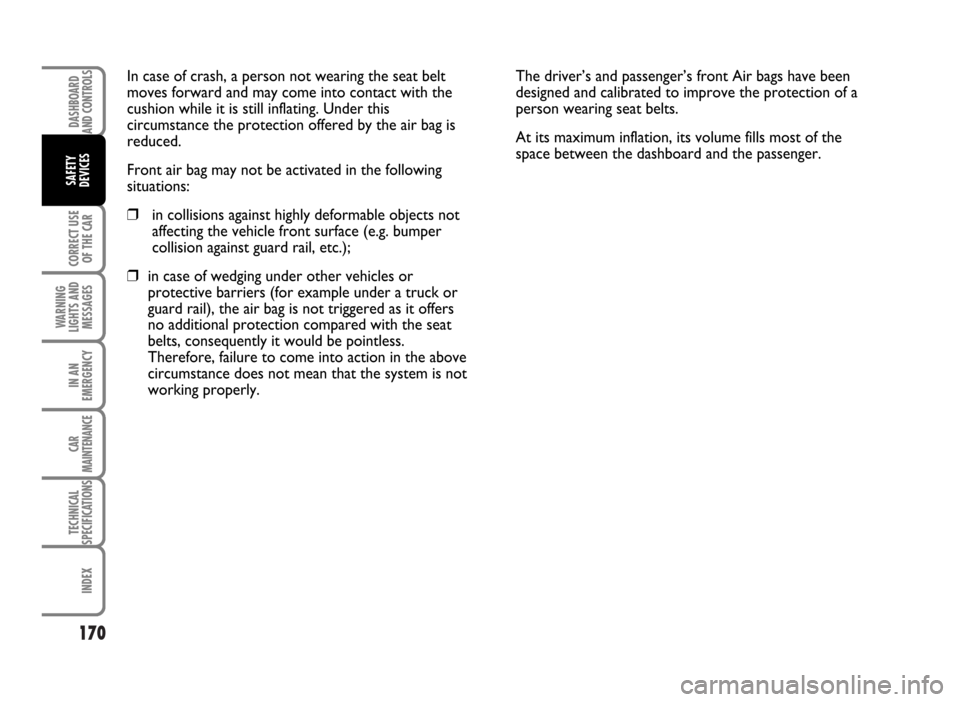
170
CORRECT USE
OF THE CAR
WARNING
LIGHTS AND
MESSAGES
IN AN
EMERGENCY
CAR
MAINTENANCE
TECHNICAL
SPECIFICATIONS
INDEX
DASHBOARD
AND CONTROLS
SAFETY
DEVICES
In case of crash, a person not wearing the seat belt
moves forward and may come into contact with the
cushion while it is still inflating. Under this
circumstance the protection offered by the air bag is
reduced.
Front air bag may not be activated in the following
situations:
❒in collisions against highly deformable objects not
affecting the vehicle front surface (e.g. bumper
collision against guard rail, etc.);
❒in case of wedging under other vehicles or
protective barriers (for example under a truck or
guard rail), the air bag is not triggered as it offers
no additional protection compared with the seat
belts, consequently it would be pointless.
Therefore, failure to come into action in the above
circumstance does not mean that the system is not
working properly.The driver’s and passenger’s front Air bags have been
designed and calibrated to improve the protection of a
person wearing seat belts.
At its maximum inflation, its volume fills most of the
space between the dashboard and the passenger.
Page 172 of 314
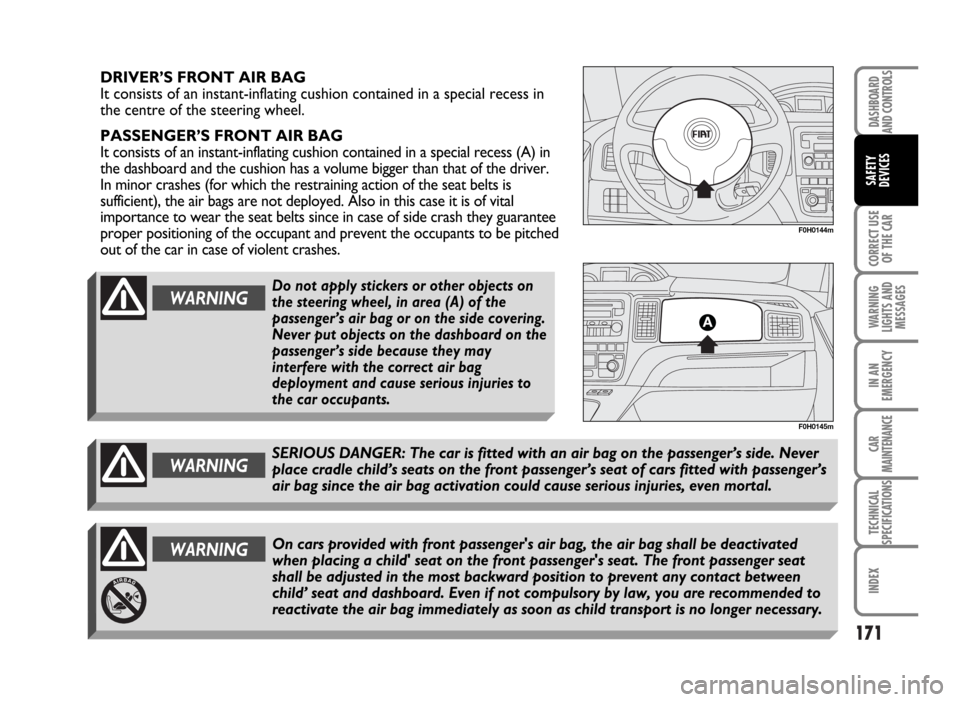
171
CORRECT USE
OF THE CAR
WARNING
LIGHTS AND
MESSAGES
IN AN
EMERGENCY
CAR
MAINTENANCE
TECHNICAL
SPECIFICATIONS
INDEX
DASHBOARD
AND CONTROLS
SAFETY
DEVICES
F0H0144m
F0H0145m
DRIVER’S FRONT AIR BAG
It consists of an instant-inflating cushion contained in a special recess in
the centre of the steering wheel.
PASSENGER’S FRONT AIR BAG
It consists of an instant-inflating cushion contained in a special recess (A) in
the dashboard and the cushion has a volume bigger than that of the driver.
In minor crashes (for which the restraining action of the seat belts is
sufficient), the air bags are not deployed. Also in this case it is of vital
importance to wear the seat belts since in case of side crash they guarantee
proper positioning of the occupant and prevent the occupants to be pitched
out of the car in case of violent crashes.
WARNINGOn cars provided with front passenger's air bag, the air bag shall be deactivated
when placing a child' seat on the front passenger's seat. The front passenger seat
shall be adjusted in the most backward position to prevent any contact between
child’ seat and dashboard. Even if not compulsory by law, you are recommended to
reactivate the air bag immediately as soon as child transport is no longer necessary.
WARNINGDo not apply stickers or other objects on
the steering wheel, in area (A) of the
passenger’s air bag or on the side covering.
Never put objects on the dashboard on the
passenger’s side because they may
interfere with the correct air bag
deployment and cause serious injuries to
the car occupants.
WARNINGSERIOUS DANGER: The car is fitted with an air bag on the passenger’s side. Never
place cradle child’s seats on the front passenger’s seat of cars fitted with passenger’s
air bag since the air bag activation could cause serious injuries, even mortal.
Page 173 of 314
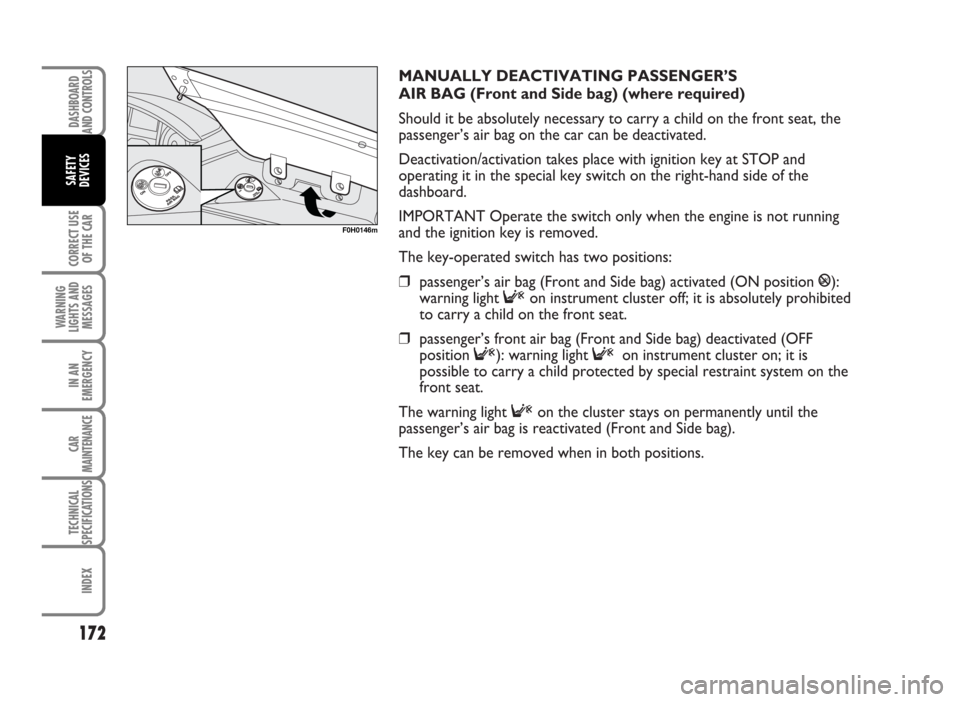
MANUALLY DEACTIVATING PASSENGER’S
AIR BAG (Front and Side bag) (where required)
Should it be absolutely necessary to carry a child on the front seat, the
passenger’s air bag on the car can be deactivated.
Deactivation/activation takes place with ignition key at STOP and
operating it in the special key switch on the right-hand side of the
dashboard.
IMPORTANT Operate the switch only when the engine is not running
and the ignition key is removed.
The key-operated switch has two positions:
❒passenger’s air bag (Front and Side bag) activated (ON position P):
warning light Fon instrument cluster off; it is absolutely prohibited
to carry a child on the front seat.
❒passenger’s front air bag (Front and Side bag) deactivated (OFF
position F): warning light Fon instrument cluster on; it is
possible to carry a child protected by special restraint system on the
front seat.
The warning light Fon the cluster stays on permanently until the
passenger’s air bag is reactivated (Front and Side bag).
The key can be removed when in both positions.
172
CORRECT USE
OF THE CAR
WARNING
LIGHTS AND
MESSAGES
IN AN
EMERGENCY
CAR
MAINTENANCE
TECHNICAL
SPECIFICATIONS
INDEX
DASHBOARD
AND CONTROLS
SAFETY
DEVICES
F0H0146m
Page 174 of 314
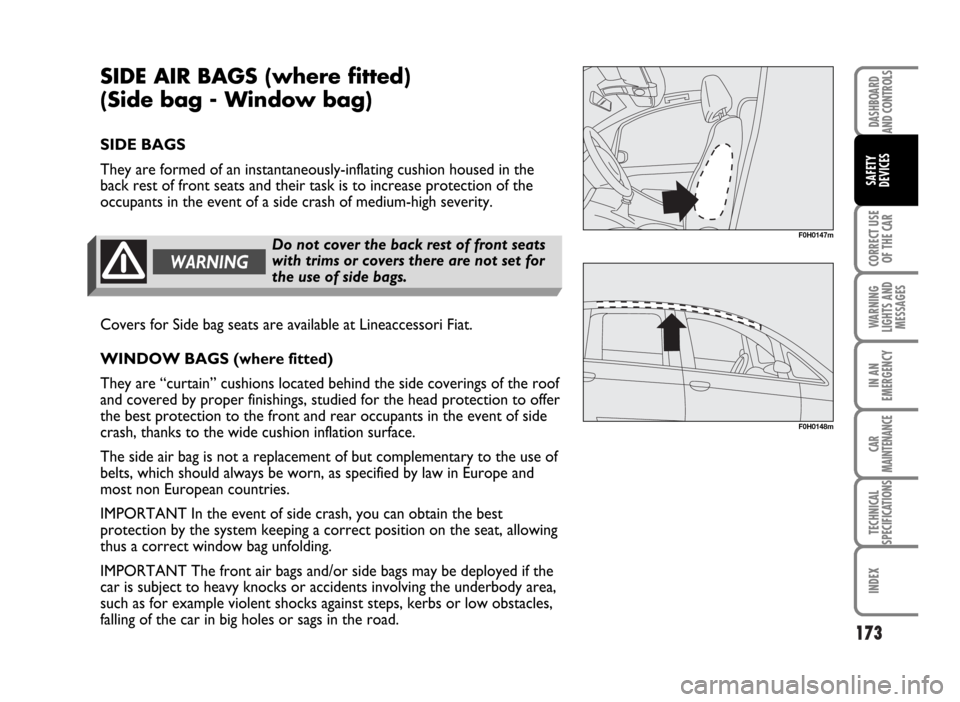
173
CORRECT USE
OF THE CAR
WARNING
LIGHTS AND
MESSAGES
IN AN
EMERGENCY
CAR
MAINTENANCE
TECHNICAL
SPECIFICATIONS
INDEX
DASHBOARD
AND CONTROLS
SAFETY
DEVICES
SIDE AIR BAGS (where fitted)
(Side bag - Window bag)
SIDE BAGS
They are formed of an instantaneously-inflating cushion housed in the
back rest of front seats and their task is to increase protection of the
occupants in the event of a side crash of medium-high severity.
F0H0147m
WARNING
Do not cover the back rest of front seats
with trims or covers there are not set for
the use of side bags.
F0H0148m
Covers for Side bag seats are available at Lineaccessori Fiat.
WINDOW BAGS (where fitted)
They are “curtain” cushions located behind the side coverings of the roof
and covered by proper finishings, studied for the head protection to offer
the best protection to the front and rear occupants in the event of side
crash, thanks to the wide cushion inflation surface.
The side air bag is not a replacement of but complementary to the use of
belts, which should always be worn, as specified by law in Europe and
most non European countries.
IMPORTANT In the event of side crash, you can obtain the best
protection by the system keeping a correct position on the seat, allowing
thus a correct window bag unfolding.
IMPORTANT The front air bags and/or side bags may be deployed if the
car is subject to heavy knocks or accidents involving the underbody area,
such as for example violent shocks against steps, kerbs or low obstacles,
falling of the car in big holes or sags in the road.